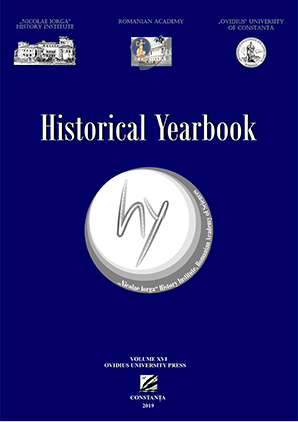HISTORICAL YEARBOOK
VOLUME XI-XII, 2014-2015
| Ileana CĂZAN, Le titre impérial et les documents diplomatiques habsbourgeois-ottomans, 1533-1606 – „N. Iorga” History Institute, Romanian Academy, Bucharest, Romania | p.5 |
| Mihai Sorin RĂDULESCU, De nouveau sur les ancetres de Matila C.Ghyka: la famille Costiesco University of Bucharest, Romania | p.23 |
| Vladimir CREȚULESCU, Nationalisme civique vs. Nationalisme ethnique, partant de Jean-Jacques Rousseau et Johann Gottfried Herder: opposition ou complémentarité ? University of Bucharest, Romania | p.41 |
| Adrian-Alexandru HERȚA, Revolution, Nationalism and Legal Innovation: the Acerbo Electoral Law „Ovidius” University of Constanța, Romania | p.71 |
| Raul DENIZE, Ideological Currents in German Interwar Historiography – „N. Iorga” History Institute, Romanian Academy, Bucharest, Romania | p.83 |
| Mihaela DENIZE, The Application of the Marxist Model of Historical Interpretation: a Comparison Between the German and Romanian Cases (1949-1956) – „N. Iorga” History Institute, Romanian Academy, Bucharest, Romania | p.95 |
| Alberto CASTALDINI, La rappresentazione della società ebraica in Italia nella recente storiografia sull’Età moderna – Babeș Bolyai University, Cluj-Napoca, Romania | p.105 |
| Aleksandr STYKALIN, Хрущев и Тито: долгий разговор о Румынии (Ленинград, июнь 1964 г.) – Slavic and Balkan Studies Institute, Russian Federation Academy, Moscow, Russia | p.123 |
| Cosmin POPA, Bucharest – Frost in the Middle of Spring – „N. Iorga” History Institute, Romanian Academy, Bucharest, Romania | p.153 |
| Mioara ANTON, Let’s fill our homes with children! Pronatalist campaigns and letters of invitation.1966-1974 – „N. Iorga” History Institute, Romanian Academy, Bucharest, Romania | p.177 |
| Georgiana ŢĂRANU, The Mythical Mussolini As Seen By Nicolae Iorga: the Statesman, the Genius, the Man – „N. Iorga” History Institute, Romanian Academy, Bucharest, Romania | p.195 |
| Viorel ACHIM, The Forced Labour of the Gypsies in Transnistria: The Regulation of December 1942 and the Reality on the Ground – „N. Iorga” History Institute, Romanian Academy, Bucharest, Romania | p.209 |
| Gabriel Stelian MANEA, The Romanian Gulag and its Characters: Camp Commanders and Political Officers at the Danube – Black Sea Canal Described in Memoirs – „Ovidius” University of Constanța, Romania | p.225 |



